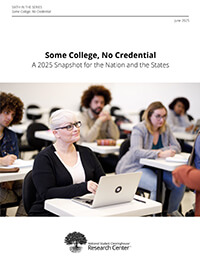Like a freight train speeding down the tracks, this alarming trend is moving fast—but in the wrong direction. America’s “some college, no degree” (SCND) population—those who started at a 2-year or 4-year college and stopped out before completing a degree or certificate—has grown to 39 million people, up nearly 9 percent in just two years.
In a world where post-high school education is crucial to good jobs and better lives, too many Americans are being left behind. National Student Clearinghouse’s (NSC) new progress report shows the SCND numbers spiking to 22 percent of U.S. adults, or nearly one in four adults. Even worse, these numbers are before the pandemic’s impact on enrollment, an impact that will drive the numbers up even more. Every state but two saw their numbers rise as of July 2020, compared to December 2018 numbers. Arizona had the steepest increase at 15 percent, and California, Texas, New York, and Illinois accounted for more than a third of SCND students.
Many of these students were younger than 35, underserved minorities, and attending community colleges when they ran into barriers, stopped out of school, and didn’t go back.
If we could change just one thing that could make a big difference for our future, it would be changing the trajectory for these 39 million learners who have been forgotten and left behind by our current system. Slowing or reversing this trend and helping millions of these students complete would improve lives, and help the U.S. reach its goal of more Americans earning postsecondary degrees or credentials.
It’s urgent that we turn this around now.
The new report by NSC, in partnership with Lumina Foundation, shines a light on this forgotten population and gives us a detailed update on them. And it offers information on the most recent nearly 1 million returning students and 60,000 credential earners. We are seeing some bright spots on NSC’s data dashboard. Florida colleges produced 7.2 percent of all first-credential earners in 2020-21, well above its 4.4 percent share of the SCND population. Meanwhile, Idaho had one of the highest perseverance rates (68.2 percent) with a relatively small share of SCND re-enrollees.
These fresh insights, along with other major new reports, provide a blueprint for educators, employers, policymakers, and community leaders on how to move forward. In other words, we know how to fix this, but it’s clear that students need:
- Funding and emergency help. A Gallup and Lumina Foundation study shows students believe college is worth it, but stress and finances hold them back. The report found financial aid is the top reason students enroll or stay in school. Emergency food banks and childcare are also crucial. Something as simple as a sick babysitter or flat tire could be the breaking point for today’s students.
- Mental health care and counseling. Students cite overwhelming stress as a reason for quitting school. Amid a rash of heartbreaking suicides on campus, suicide is now the second-leading cause of death for people aged 10 to 24. We must provide readily available, affordable mental health care through online and real-time therapists and emergency hotlines.
- Time and clear academic pathways. A report from Higher Education Insight found most returning adult students can complete degrees or credentials if they have enough time and support. To balance school and jobs, they need online and/or hybrid courses and convenient class times. They need clear academic pathways, twinned with helpful admissions staff, rolling admissions and transfer credits.
- Help breaking down bureaucratic barriers. The “Degrees When Due” report from the Institute for Higher Education Policy found that for many students, the most significant obstacles to degrees were bureaucratic, such as incomplete paperwork or account holds.
- Focused support for students of color. Students of color are 30 percent more likely than white students to stop out of college, increasing longstanding equity gaps. Black, Hispanic and Latino, and Native American students thrive with attentive support, aid, mentoring, and culturally aware mental health counseling.
Next steps
For communities to meet their talent needs of today and tomorrow, and help citizens have good jobs and good lives, they must focus on these forgotten 39 million stopped-out students. As I said, we know what to do. It’s time to reverse this trend, get these forgotten students back on track—and help millions successfully complete a valuable degree or certificate.

